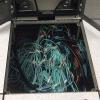According to the U.S. Department of Commerce, Economics and Statistics Administration, women make up less than one-quarter of those employed in STEM (science, technology, engineering, math) occupations in the United States. Not only does this mean that women in STEM remain a disproportionate minority, but it also contributes to STEM field underemployment in the U.S., with not enough properly trained candidates to fill science and technology jobs.
SI
Over the past five years, I have had the privilege of working with the Summer Institute program at the Ohio Supercomputer Center. Summer Institute, SI for short, is “a two-week residential program that gives gifted Ohio high school students project-based, hands-on learning,” and each year is a unique experience for both myself and the students who participate in this program.
Over the weekend of June 12-13, 2015, staff members of the Ohio Technology Consortium’s (OH-TECH) Shared Infrastructure (SI) unit moved systems and storage from the Kinnear Road Data center (KRC) at The Ohio State University to the State of Ohio Computer Center (SOCC). While not a common event, this was not the first time that I have been responsible for moving equipment from KRC to the SOCC.
As an educator, I feel that it is important to help young people develop an understanding and appreciation of science and technology. It is also important that all students should be introduced to STEM (Science, Technology, Engineering, and Math) careers. Yet the U.S. Census Bureau reports that women remain underrepresented in STEM fields, particularly in computer science and engineering occupations. If we are to increase the number of women in STEM fields then we should make sure that girls are given ample opportunities to explore science and technology.





